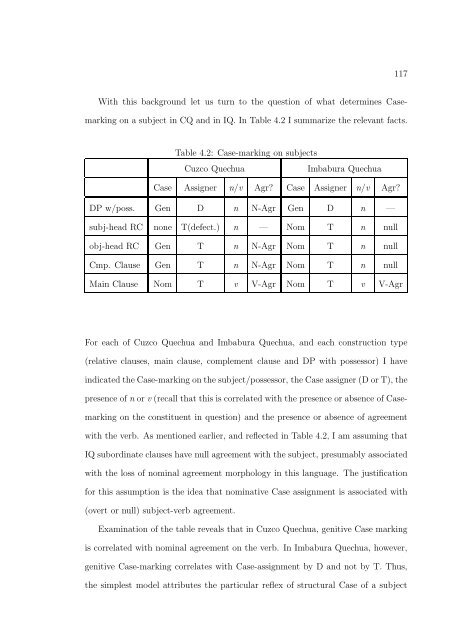the syntax and semantics of relativization and quantification
the syntax and semantics of relativization and quantification
the syntax and semantics of relativization and quantification
You also want an ePaper? Increase the reach of your titles
YUMPU automatically turns print PDFs into web optimized ePapers that Google loves.
117<br />
With this background let us turn to <strong>the</strong> question <strong>of</strong> what determines Casemarking<br />
on a subject in CQ <strong>and</strong> in IQ. In Table 4.2 I summarize <strong>the</strong> relevant facts.<br />
Table 4.2: Case-marking on subjects<br />
Cuzco Quechua<br />
Imbabura Quechua<br />
Case Assigner n/v Agr? Case Assigner n/v Agr?<br />
DP w/poss. Gen D n N-Agr Gen D n —<br />
subj-head RC none T(defect.) n — Nom T n null<br />
obj-head RC Gen T n N-Agr Nom T n null<br />
Cmp. Clause Gen T n N-Agr Nom T n null<br />
Main Clause Nom T v V-Agr Nom T v V-Agr<br />
For each <strong>of</strong> Cuzco Quechua <strong>and</strong> Imbabura Quechua, <strong>and</strong> each construction type<br />
(relative clauses, main clause, complement clause <strong>and</strong> DP with possessor) I have<br />
indicated <strong>the</strong> Case-marking on <strong>the</strong> subject/possessor, <strong>the</strong> Case assigner (D or T), <strong>the</strong><br />
presence <strong>of</strong> n or v (recall that this is correlated with <strong>the</strong> presence or absence <strong>of</strong> Casemarking<br />
on <strong>the</strong> constituent in question) <strong>and</strong> <strong>the</strong> presence or absence <strong>of</strong> agreement<br />
with <strong>the</strong> verb. As mentioned earlier, <strong>and</strong> reflected in Table 4.2, I am assuming that<br />
IQ subordinate clauses have null agreement with <strong>the</strong> subject, presumably associated<br />
with <strong>the</strong> loss <strong>of</strong> nominal agreement morphology in this language. The justification<br />
for this assumption is <strong>the</strong> idea that nominative Case assignment is associated with<br />
(overt or null) subject-verb agreement.<br />
Examination <strong>of</strong> <strong>the</strong> table reveals that in Cuzco Quechua, genitive Case marking<br />
is correlated with nominal agreement on <strong>the</strong> verb. In Imbabura Quechua, however,<br />
genitive Case-marking correlates with Case-assignment by D <strong>and</strong> not by T. Thus,<br />
<strong>the</strong> simplest model attributes <strong>the</strong> particular reflex <strong>of</strong> structural Case <strong>of</strong> a subject
















